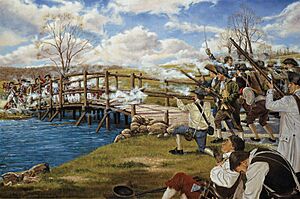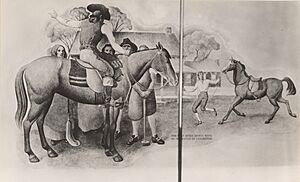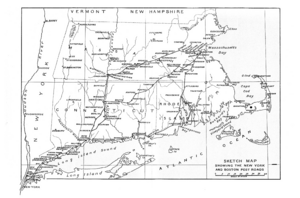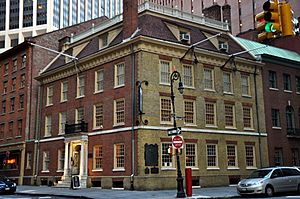Israel Bissell facts for kids
Quick facts for kids
Israel Bissell
|
|
|---|---|
| Born | 1752 |
| Died | October 24, 1823 (aged 71) Hinsdale, Massachusetts, United States
|
| Other names | Israel Bissel |
| Occupation | Post rider, colonial militia officer |
| Spouse(s) | Lucy Hancock (1784–1823; his death) |
| Children | 4 |
Israel Bissell, also spelled Bissel (1752 – October 24, 1823), was a brave Patriot who delivered important messages during the American Revolutionary War. He worked as a post rider, carrying mail between Boston, Massachusetts and New York.
On April 19, 1775, British soldiers fired on American colonists in Lexington and Concord. This event started the American Revolutionary War. Israel Bissell was given a very important job: to warn American colonists about the fighting. He needed to gather them to help the minutemen in Massachusetts.
Bissell carried the urgent message, known as the Lexington Alarm, through many areas. He rode through eastern Massachusetts, Connecticut, New York City, New Jersey, and finally to Philadelphia, Pennsylvania. Along his journey, Bissell shouted, "To arms, to arms, the war has begun!" He also carried a message from Joseph Palmer. This message asked towns to send soldiers to join the fight. Because of Bissell's ride, leaders like Benedict Arnold from New Haven and Israel Putnam from Pomfret quickly gathered soldiers. These soldiers then headed to the battlegrounds in Massachusetts.
Contents
Early Life of Israel Bissell
Israel Bissell was born in 1752 in East Windsor, Connecticut. At that time, it was part of the British Colonies. His family had moved there from England.

Bissell worked as a post rider for the British government. He carried mail between Boston and New York. But when the British fired Benjamin Franklin from his postal job, the American Patriots created their own mail system. Bissell then started working for them. He carried mail and secret messages for groups like the Sons of Liberty. As the possibility of war grew, the Massachusetts Committee of Safety chose Bissell. They picked him to carry the urgent news when the war finally began.
The Lexington Alarm Ride
The Urgent Message
On April 19, 1775, Joseph Palmer from the Committee of Safety sent Israel Bissell on a crucial ride. His mission was to warn colonists that the war with Britain had started. The goal was to get soldiers from five colonies to help the minutemen in Massachusetts. These minutemen were fighting at the Battles of Lexington and Concord.
Bissell carried this "call to arms" message. He rode to Worcester, then south and west through Connecticut, and eventually to Philadelphia. The message he carried explained what had happened. It said that British soldiers had fired on American militia, killing and wounding several men. The message asked everyone to help Bissell get fresh horses. It also asked them to spread the word.

Bissell left Watertown and rode to Worcester. He passed many people heading towards Lexington. As he rode, he yelled, "To arms, to arms, the war has begun!" Townspeople heard him and rang church bells. They also fired cannons to alert their neighbors.
Bissell rode very fast, covering about 69 miles (111 km) each day. His whole journey was about 345 miles (555 km). This meant he needed fresh horses often. It is said that his first horse was exhausted after the ride from Watertown to Worcester. He covered about 36 miles (58 km) in just two hours. This was usually a one or two-day trip for a post rider.
When Bissell reached New Haven, the message was updated. It now included an order to take the news all the way to Philadelphia. In New York, General Alexander McDougall also added a note. He asked for a new rider to carry the message to Philadelphia. However, many historians believe Israel Bissell rode the entire way to Philadelphia himself. From New York, the message continued through New Jersey before reaching Philadelphia.
Journey Timeline

The timeline of Bissell's ride shows how quickly the news spread. People at each stop signed the message to confirm they had received it.
- April 19, 10 a.m., Watertown, Massachusetts
- April 19, Worcester, Massachusetts
- April 20, Pomfret, Connecticut - Bissell told Israel Putnam, who was plowing his fields, that the war had started.
- April 20, 11 a.m., Brooklyn, Connecticut
- April 20, 4 p.m., Norwich, Connecticut
- April 20, 7 p.m., New London, Connecticut
- April 21, 1 a.m., Lyme, Connecticut, where he crossed the Connecticut River by ferry.
- April 21, 4 a.m., Old Saybrook, Connecticut
- April 21, 7 a.m., Killingworth, Connecticut
- April 21, 8 a.m., East Guilford, Connecticut
- April 21, 10 a.m., Guilford, Connecticut
- April 21, noon, Branford, Connecticut
- April 21 or 22, New Haven, Connecticut
- April 22, 8 a.m., Fairfield, Connecticut
- April 23, 2 p.m., received by General McDougall in New York City. It was confirmed at a 4 p.m. meeting of the Committee of Sixty on Wall Street.
- April 24, Elizabeth, New Jersey
- April 24, 2 a.m., New Brunswick, New Jersey
- April 24, 6 a.m., Princeton, New Jersey
- April 24, 9 a.m., Trenton, New Jersey
- April 24, 5 p.m., Philadelphia
After Bissell's arrival, people in towns along his route were alerted. They fired muskets and rang church bells to spread the news. Benedict Arnold of New Haven and Israel Putnam of Pomfret quickly gathered their soldiers. They marched to Massachusetts to join the fight. Putnam led the Connecticut Militia to Boston. Arnold formed a group of soldiers in New Haven, including Yale College students.
When the news reached Manhattan, New York City, a riot broke out. Colonists took weapons from City Hall. They also seized supplies meant for Boston. Patriots set two ships on fire, closed the port, and took over the Custom House. Many men joined the militia. By the time the Lexington Alarm reached Philadelphia, 50,000 armed colonists were marching towards Boston. In Philadelphia, 8,000 people gathered when they heard the Liberty Bell ringing.
After his incredible ride, Bissell returned to Connecticut. Copies of the message were sent to other places, like Maryland and North Carolina.
Two Riders Named Bissell
It's important to know that there were two post riders named Bissell. They both carried news of the war's start. Isaac Bissell took a different route. He rode west from Worcester to Hartford, then through the Connecticut countryside.
Israel Bissell, the subject of this article, spread the word about the war's beginning. His usual mail route was from Boston to New York. The message he carried through Connecticut and to New York clearly named him as the messenger.
After the War
After his famous ride, Israel Bissell joined the army with his brother, Justis. They both served with men from East Windsor, Connecticut. His father, Israel Sr., also fought in the war. Israel Bissell served in June 1775 and again in 1776. When his father died in 1776, Bissell returned home to take care of the family farm.
After the war ended, Bissell moved to Middlefield, Massachusetts. He became a sheep farmer there. He married Lucy Hancock and they had four children. In 1790, Bissell, his wife, and three children moved to a farm in Hinsdale, Massachusetts. Israel Bissell passed away there on October 24, 1823. He was buried in the Maple Street Cemetery in Hinsdale. In 1967, the Daughters of the American Revolution placed a special marker at his grave. It honors him as the post-rider who alerted towns about the British attack at Lexington.
Legacy
Israel Bissell's ride is an important part of American history. He played a key role in spreading the alarm that helped rally colonists to fight for their freedom.


